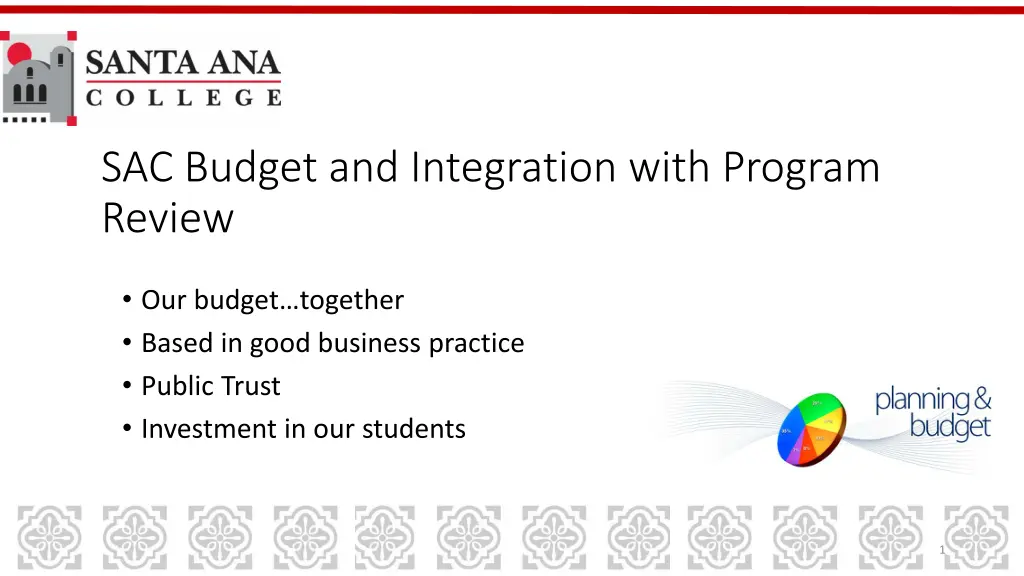
Integrating Budget with Program Review for Effective Resource Allocation
Explore the strategic integration of budgeting with program review to align resource allocation requests with college goals, mission, and budget priorities. Learn about the Planning and Budget Manual, monthly committee presentations, and budget parameters to ensure fiscally responsible budgeting practices.
Download Presentation

Please find below an Image/Link to download the presentation.
The content on the website is provided AS IS for your information and personal use only. It may not be sold, licensed, or shared on other websites without obtaining consent from the author. If you encounter any issues during the download, it is possible that the publisher has removed the file from their server.
You are allowed to download the files provided on this website for personal or commercial use, subject to the condition that they are used lawfully. All files are the property of their respective owners.
The content on the website is provided AS IS for your information and personal use only. It may not be sold, licensed, or shared on other websites without obtaining consent from the author.
E N D
Presentation Transcript
SAC Budget and Integration with Program Review Our budget together Based in good business practice Public Trust Investment in our students 1
RAR! The process intends to link all college resource allocation requests to the department/division goals, the college mission, the strategic plan and the college budget priorities. The Resource Allocation Request Form outlines the college mission and the budget priorities; the form has a link to the SAC Strategic Plan document for easy reference. 2
Planning and Budget Manual The Planning and Budget (P&B) Manual Budget priorities recommended by the Planning and Budget Committee which are then used by campus departments to develop their Resource Allocation Request forms (RARs). The P&B manual includes: A comprehensive planning and budget calendar The district &SAC Tentative and Adopted budget calendars Budget guidelines and accounting procedures that facilitate the daily budget transactions such as account requests, budget changes and transfer of expenditures. SAC P&B Manual is located on the SAC Budget Office website Planning and Budget Committee website for current budget information 3
Budget Development Integrated with Program Review Budget Education/Information is important! Monthly P&B Committee Presentations: Enrollment Student Life SAC TAC Marketing Accreditation Financial Context State, District and SAC budget updates and information Monthly Financial Statements January Governor s Budget May Revise Budget Tentative and Adopted Budget Workshop Presentations 4
SAC Budget Parameters District and College Mission Program review/Planning Strategic goals inform dept. objectives- both link to RARs driven from program review Fiscally Responsible Budget Balanced budget Designated contingency (SAC P&B committee = 20% of ending balance ) Community College Regulations 50% law (instructional salaries/benefits >=50%) FON (full time faculty obligation) 5
Budget Parameters FTES- Based on target established by local funding model Revenues- Based on apportionment, growth, COLA, categorical allocations from Chancellor s office, local revenue Expenses- Based on prior year college expenses, and anticipated increases or decreases in coming year Forced Costs External: legal, contractual, risk, health/safety Critical operations: Utilities, insurance, maintenance Enrollment management: FTES growth in targeted area, marketing Department viability: crucial for department function Other resources Categorical/Grant funds, facilities funds, lottery 6
Budget Augmentations- RARs When additional revenue is available above 20% contingency reserve Equipment, facilities modifications, technology, personnel Augmentations are one-time ST personnel are one-time expenditures FT/PPT personnel are ongoing expenses 7
Program Review Informs other Budget Related Processes Full time staffing needs Facility renovation or modification Technology needs or update 8
Use of Data Informs Budget Decisions Examples include: Student learning outcome (SLO) data Enrollment management trends Expenditure history and trends (deficit spending or savings) Forced costs (licenses, training, accreditation, preventive maintenance) Bang for the buck initiatives Return on investment- was an initiative so successful it can be generalized across the college? How do you measure the impact? 9
Sources of Funding for RARs Lottery Funds- Instructional supplies Categorical Funds (Fund 12) SSSP, Student Equity, etc. Very restrictive Scheduled Maintenance/Fund 41/ Prop 39 One-Time funds (Fund 13) Ongoing General Fund (Fund 11)- mainly personnel and forced costs 10
RAR Requests must be Tied to Planning Goals Justifications must be listed in comments Objectives need to make sense I need more staff that you took away in 2010 Increase in sections requires additional lab technicians to serve additional students 11
Budget Communication/Transparency Planning and Budget Committee- updates, RARs, budget assumptions, tentative/adopted budget summaries Board budget presentations College Council, Management Team Meeting budget presentations Campus-wide budget email updates Final RAR approvals distributed to division deans and managers to be shared with faculty and team members Planning and Budget Manual- updated annually Trainings by SAC Budget Office staff All Planning and Budget information and minutes posted on SAC Planning and Budget web page 12
November Budget priorities are determined and approved by SAC Budget and Planning Committee. (November) Administrative Services sends out Resource Allocation Request (RAR) forms. (November) The form needs to include items that have been identified and justified in the department program review The requests need to be prioritized by the program areas, including direct ties to college budget priorities, college mission, strategic plan, and intended outcomes 13
December All program area RARs and supporting evidence needs to be submitted to the area Vice President and simultaneously to the Campus Budget office by the deadlines established. (December) 14
January Campus Budget office compiles college-wide Resource Allocation Requests (January) Segregates requests by VP areas with priorities included Segregates request by specific request type (personnel, facilities, equipment etc,) Provides comprehensive list of RAR s to area vice presidents. Requests are reviewed and prioritized by Cabinet (January) Prioritized Resource Allocation Requests are presented to Cabinet by area vice president. Cabinet prioritizes college-wide RARs in accordance with college budget priorities, strategic plan, college mission and direct tie to dept/division intended outcomes 15
February Administrative Services provides prioritized list of Resource Allocation Request to Planning and Budget for review (February) 16
March/April/May Area Vice Presidents review prioritized list with respective departments/divisions and communicate the location of possible funding. Some requests might be funded in the Tentative Budget, during the Adopted Budget or possibly later depending on funding availability and state budget information 17
September Vice President of Administrative Services preliminarily assigns funding categories and sources of funds to prioritized RARs, and presents the information to cabinet and the Planning and Budget Committee. Allocation of funds is validated after approval of Adopted Budget. (September) Planning and Budget committee as well as management teams are provided with the final prioritized RAR list by VP area. (September) If there are items that were not approved and the departments can still justify the need, these items could be included in the Resource Allocation Request for the following year. 18
RAR Considerations for Budget Development Justification/Integrity Safety! Department viability Space, staff, equipment, etc. to expand a program for greater results (student success/ # of FTES generated) Discretionary Expenses- Trend with FTES production Instructional supplies, equipment, staffing Equipment (including technology) New or replacement equipment based on life cycle schedule, new technology requirements, obsolescence Equipment maintenance and repair Based upon manufacture specifications Total Cost of Ownership 19
SAC ACADEMIC AFFAIRS ANNUAL RAR PROCESS August November Individual departments and programs assess and rank their resource allocation needs that are in alignment with the college mission, strategic plan, and budget priorities. Requests are based on program review, outcomes & assessment work, legal mandates, and safety concerns. These requests are developed into Resource Allocation Requests (RARs) and submitted to their Division Office; November December The Division Dean leads a ranking process working with department chairs and program directors to develop an overall division ranking for all submitted RARs; December (12/16/17) The Division Offices submit their ranked RARs to their area VP and Administrative Services for consolidation March April Academic Affairs Division Deans and VP meet to prioritize the area RARs Prioritized area RARs go to Executive Cabinet for discussion and final prioritization 20
Assessment of the RAR Process 2015/16 Fall 2016 assessment of the RAR process effectiveness and efficiency was conducted institution-wide. 125 SAC employees were designated by the Deans as having been involved with and participated in the RAR process. Survey was sent out twice with a descriptive note 16 faculty responded, 1 staff member, 9 administrators Findings included: 1. Communication throughout the RAR process was not satisfactory- Close the Loop! 2. Low satisfaction with the process outcomes at the end of the funding cycle 3. After funding is approved and purchases made, did it make a difference? 4. Simplify the process (online, tie electronically to SLOs & institutional info) 21
Changes to RAR Process in Academic Affairs for 2017-18 Increased Participation Faculty Chair representation in Academic Affairs RAR Prioritization meeting in February. Communication and Feedback Once Academic Affairs RARS have been prioritized, this list will be sent out to the Division Offices for distribution to faculty and staff. Return on Investment Areas that received funding will in the 2015-2016 cycle will be asked to report on RAR impact on students and programs. 22




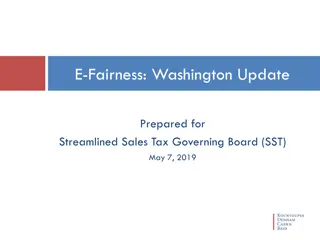


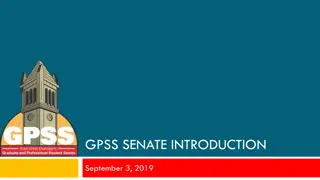



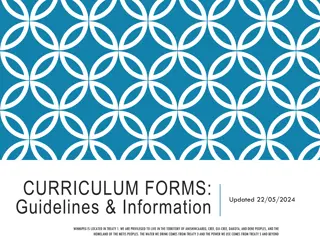
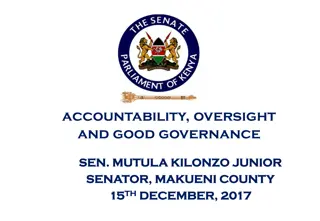

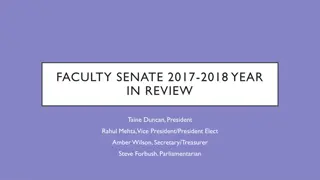
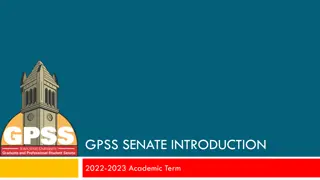
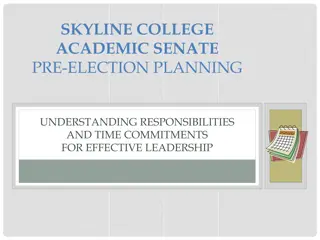
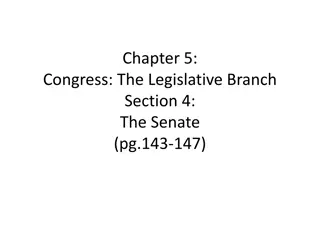
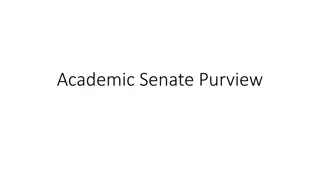

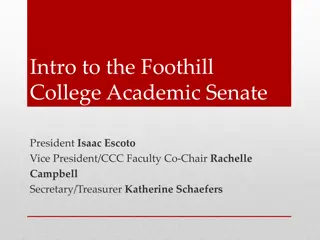
![Overview of the Faculty Senate at [Institution Name]](/thumb/233771/overview-of-the-faculty-senate-at-institution-name.jpg)
